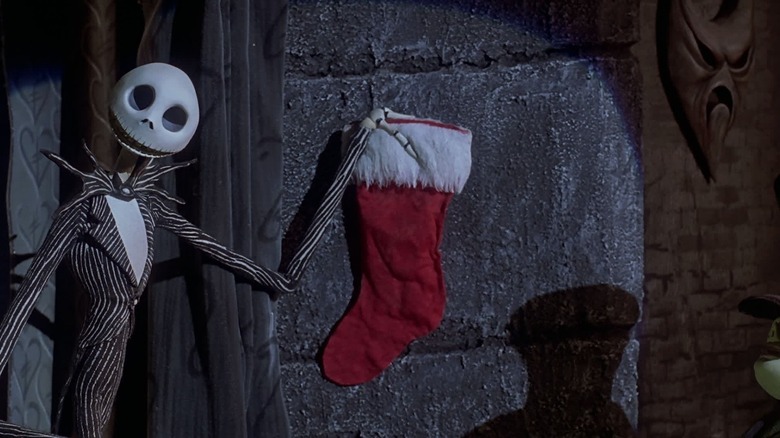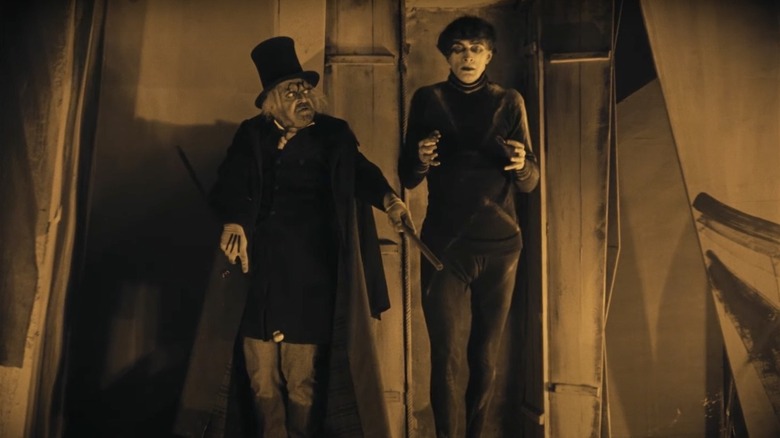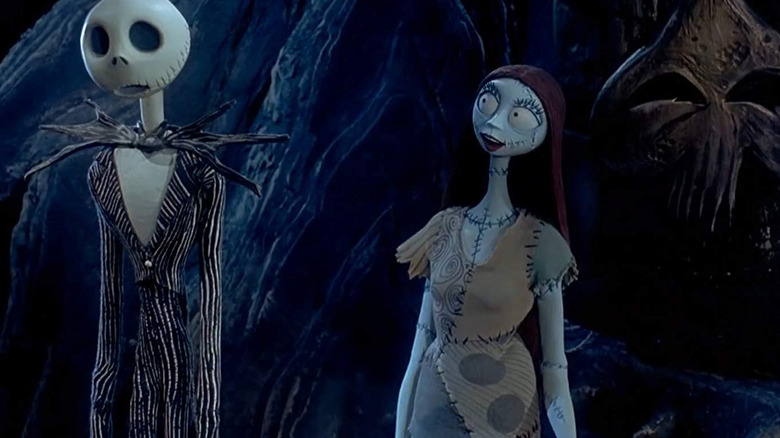How A Legendary Horror Classic Influenced Nightmare Before Christmas
Tim Burton loves to make things spooky and morbid, but his favorite holiday might well be Christmas. Look at how many of his films take place during the Yuletide season: "Batman Returns," "Edward Scissorhands," etc. He also conceived of "The Nightmare Before Christmas," which is all about Halloween Town's top ghoul, Jack Skellington (Chris Sarandon), getting Christmas fever. While Burton handed off directing duties of the stop-motion picture to Henry Selick, it's easy to see his fingerprints and why he would empathize with Jack.
David A. Bossert's "Tim Burton's The Nightmare Before Christmas Visual Companion" was released this year for the film's 30th anniversary. The book features interviews with the film's crew, from Selick to Art Director Kelly Asbury, where they describe forming the film's distinct visual style — since there were multiple holiday-themed dimensions, they couldn't stick to just one aesthetic.
For Halloween Town, though, they took after Burton's live-action films ("Edward Scissorhands" is specifically mentioned). Indeed, they went back and studied the roots of Burton's own influences. Among them were the Gothic artists Edward Gorey and Charles Addams (creator of "The Addams Family"). Asbury explained how Burton's art style takes after them: "A lot of crosshatching, a lot of texturing, very spontaneous looking, but at the same time very detailed texturing and squiggles and swirls."
Then there was Burton's cinematic style influence, German Expressionism. This unnaturalistic art style was dominant during the early 20th century and so bled into the style of early German filmmaking. Expressionism mixed with black-and-white silent film resulted in cinema with harsh shadows plus angular and unnatural architecture. This dark and fantastical style is part of the lineage of Burton's artistry.
When designing "The Nightmare Before Christmas," the crew looked to one German Expressionist film in particular: "The Cabinet of Dr. Caligari."
The Cabinet of Dr. Caligari
"The Cabinet of Dr. Caligari," directed by Robert Wiene, is one of the first horror film classics and the go-to example of German Expressionist cinema. The titular doctor (Werner Krauss) enslaves Cesare (Conrad Veidt) with hypnotism, forcing the man to commit murders while the town sleeps. The film's contrast is created not just with lighting but painting; darkness and light were etched onto the set, making the setting feel like a drawing come to life. The dissonance between the sets and real actors makes for a more alien setting and, thus, a more immersive film. The overpowering darkness in "The Cabinet of Dr. Caligari" is still creepy even through the lack of sound and the grain of surviving film stocks; I can only imagine how terrified 1920s audiences must've been when they first experienced it.
The film's poster is a drawing done in German Expressionist style with the full spectrum of color, leading to an orange sky and a greenish tint nowhere to be seen in the actual film. Even so, the setting is so unnatural that these color choices wouldn't look out of place. If you want another example of a German Expressionist film in color, check out "The Nightmare Before Christmas."
Bringing German Expressionism to stop-motion
Notice how nothing in Halloween Town stands straight up. The houses all have an almost hourglass shape, thinning out in the middle, while cobblestone roads and hills alike all curve. As Asbury recounts in the Burton book, this was all intentional:
"That was the visual directive for Halloween Town. The trees; the area where Jack walks into, that's someplace new. It had to be very vertical/horizontal, the swirly ground; those were directly from Tim Burton's drawings. That was the world."
The Expressionistic, "Caligari"-esque art style even reflects the characters. Jack resembles the outline of Cesare; a thin black body with long limbs and a pale white face and hands. The triangular Mayor of Halloweentown invokes Dr. Caligari himself, being short, plump, and adorned with a top hat. Sally, a living doll who's been stitched together, has the same mismatched color pattern as many German Expressionist paintings.
Bossert's book, though, emphasizes the "Nightmare" crew's reference materials were only inspiration. He writes: "All artists use reference art for inspiration; it is a given that most things that are created are derivative of other things." Selick, Asbury, and their peers walked in the footsteps of Weine, Gorey, Addams, and Burton to distill a unique vision into an enduring classic.


